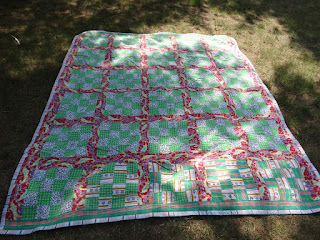A Parks Canada plaque states, "This island and adjacent Wilson's Point were the site of an encampment of refugee Acadians following their expulsion from Nova Scotia in 1755. Established by a Canadian officer, Charles des Champs de Boolshebert from whom the island derives it name (apparently the locals could not pronounce his name properly so it came out as Beaubears), the settlement was destroyed by an English naval force in 1760. During the 19th century, the island was an important lumbering and shipbuilding centre. Several well-known Miramichi figure were owners of the shipyard here including James Fraser, Joseph Russell and John Harley".
Today, the island has several trails, a monument, a large population of foxes and the remnants of buildings once used during the busy shipbuilding era. When we first visited the island, we were taken over via a small ferry and enjoyed a catered picnic lunch with sandwiches, salads and lovely desserts. Blankets and quilts were laid on the ground for people to recline and enjoy their picnic lunches. We joined characters from the era. They all did a great job staying in character during the picnic. Acting as host for this event was none other than the former island owner and one of the Fathers of Confederation, Peter Mitchell. We listened to political stories of the day. Mitchell, during his more than twenty years as proprietor of the Island, hosted a number of gatherings on the island. The gathering in 1872, hosted by Mitchell, had an estimated attendance of three thousand.
 |
| Political character and host: Peter Mitchell. He is telling us about some political issue of the day. |
 |
| Other characters at the picnic |
 |
| A group of youth waiting for the picnic to start. The young women assured me that the young lad was always a troublemaker. |
 |
| Images of olden days |
 |
| A professional photographer took this photo with a character from the past. We just don't fit in. |
At the end of our stay on the island we walked some of the trails and ended up at the iconic Canadian Red Chairs.
Siting on the famous "Red Canadian Chairs"
 |
| This is the view from the Red Chairs. I love the angle of the tree. |
Several weeks later, we tried again to canoe the Miramichi River and finally we were sent off with two guides. The weather was just right with smooth water.
 |
| Here is Al paddling away |
 |
| Here I am paddling away. It had been many, many years since we had been in a canoe. I was working hard but spent a lot of time being the photographer. |
 |
| One guide sat in front of me. We are paddling against the current. The island is on the right. |
 |
| Looking ahead. |
 |
| Apparently there is a large population of foxes on the island. Both guides said that even though they grew up in the area, they had never seen a fox on the island. Well, we were very lucky to have a fox follow along with us for quite a while. The fox along the beach and us in the canoe. Nice and quiet, we were. |
We stopped at Wilson's Point which is the location where Acadians sought refuge in 1755.
A memorial plaque stated the following:
"Led by French officer Charles Deschamps de Boishebert, several thousand Acadians sought refuge here at the forks of the Miramichi during the deportation that began in 1755. After hundreds died from famine and disease between 1756 and 1758, many of the survivors fled to Quebec and to the Baie des Chaleurs area. While most traces of their temporary settlement, known as Camp de l'Esperance, are found on Wilsons Point, Beaubears Island was an integral part of the community. The Boishebert settlement represents an important chapter of the Acadian experience in the Maritime provinces."
 |
| Part of the monument for the Acadian Upheaval |
Leaving Wilson's Point we travel around the back side of Beaubears Island. The current and the landscape is very different due to the winds and waves on this side of the island.
 |
| Now travelling on the back side of the island |
 |
| The shore line is very stony with large rocks. |
 |
| The layers of sedimentary rock are visible. |
Back on Beaubears Island we explored some more and learned that in the late 19th century, there used to be a baseball diamond on the island and teams from nearby towns would play here. Baseball was played up until the mid 20th century. All that is left of the playing field is open green space.
 |
| The wood on Beaubears Island was cut for the lumber used in shipbuilding. |




No comments:
Post a Comment